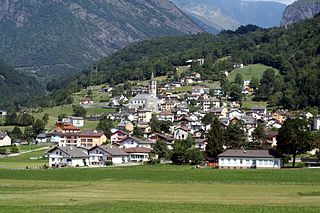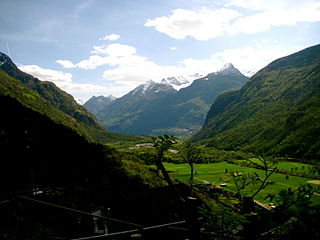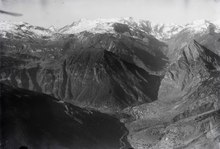
Ticino, sometimes Tessin, officially the Republic and Canton of Ticino or less formally the Canton of Ticino, is one of the 26 cantons forming the Swiss Confederation. It is composed of eight districts and its capital city is Bellinzona. It is also traditionally divided into the Sopraceneri and the Sottoceneri, respectively north and south of Monte Ceneri. Red and blue are the colours of its flag.

Locarno is a southern Swiss town and municipality in the district Locarno, located on the northern shore of Lake Maggiore at its northeastern tip in the canton of Ticino at the southern foot of the Swiss Alps. It has a population of about 16,000 (proper), and about 56,000 for the agglomeration of the same name including Ascona besides other municipalities.

Bellinzona is a municipality, a historic Swiss town, and the capital of the canton of Ticino in Switzerland. The town is famous for its three castles that have been UNESCO World Heritage Sites since 2000.

Cugnasco is a village in the municipality Cugnasco-Gerra of the district of Locarno in the canton of Ticino in Switzerland.
Ghirone was a municipality in the district of Blenio in the canton of Ticino in Switzerland.

Biasca is a town of the district of Riviera in the canton of Ticino in Switzerland.

Lavizzara is a municipality in the district of Vallemaggia in the canton of Ticino in Switzerland.
Gerra (Verzasca) is a part of the municipality of Cugnasco-Gerra in the district of Locarno in the canton of Ticino in Switzerland.

Alto Malcantone is a municipality in the district of Lugano in the canton of Ticino in Switzerland. It was formed on 13 March 2005 from the earlier municipalities of Arosio, Breno, Fescoggia, Mugena and Vezio.

Breno is a village and former municipality in the canton of Ticino, Switzerland.

Blenio is a municipality of the district of Blenio, in the canton of Ticino, Switzerland.

The Castles of Bellinzona are a group of fortifications located around the town of Bellinzona, the capital of the Swiss canton of Ticino. Situated on the Alpine foothills, the group is composed of fortified walls and three castles named Castelgrande, Montebello and Sasso Corbaro. Castelgrande is located on a rocky peak overlooking the valley, with a series of walls that protect the old city and connect to Montebello. Sasso Corbaro, the highest of the three castles, is located on an isolated rocky promontory south-east of the other two. The Castles of Bellinzona with their defensive walls have been an UNESCO World Heritage Site since 2000.

Cugnasco-Gerra is a municipality in the canton of Ticino, Switzerland. It was formed on January 1, 2009, through the merger of Cugnasco and Gerra.

Gambarogno is a municipality in the district of Locarno in the canton of Ticino in Switzerland. It was created on 25 April 2010 through the merger of the municipalities of Caviano, Contone, Gerra, Indemini, Magadino, Piazzogna, San Nazzaro, Sant'Abbondio and Vira.

Monteceneri is a municipality in the district of Lugano in the canton of Ticino in Switzerland. It was created on 21 November 2010 through the merger of the municipalities of Medeglia, Bironico, Camignolo, Rivera and Sigirino. The first mayor elected was Emilio Filippini, who held the position until 2016.1

Glarus Nord is one of three municipalities of the canton of Glarus, Switzerland.

The Rein da Medel is the longest headwater of the Rhine. It is located in the Swiss cantons of Ticino and Graubünden and flows through the valleys Val Cadlimo and Val Medel. Rein da Medel is the local Sursilvan, name in Graubünden, which is commonly used to denote the ticinese part as well.

Serravalle is a municipality in the district of Blenio in the canton of Ticino in Switzerland. It was formed on 1 April 2012 by the merger of the former municipalities of Malvaglia, Semione and Ludiano.

Verzasca is a municipality in the district of Locarno in the canton of Ticino in Switzerland.

The Fabbrica di Cioccolato Cima Norma S.A., also Chocolat Cima-Norma S.A., in Torre-Dangio was an industrial chocolate production company in the canton of Ticino. It was founded in 1903 by the Cima brothers. It went bankrupt in 1968. The company Cima Norma S.A. also stands for the economic development and modernization advancement goal from the beginning of the 20th century for the mountain valley Blenio Valley, which was classified as a peripheral region.























